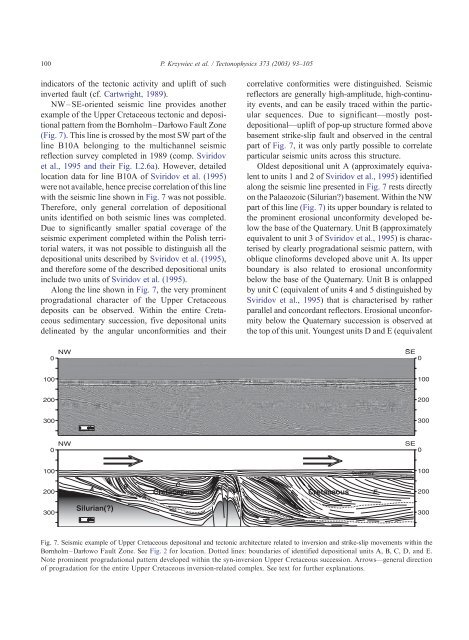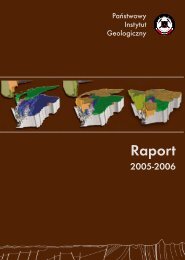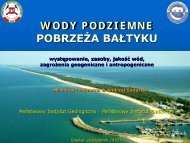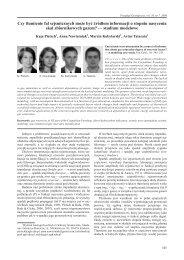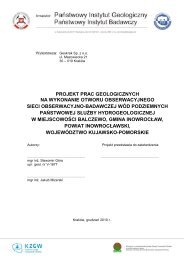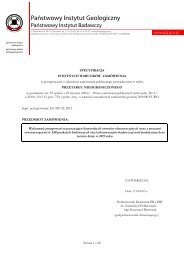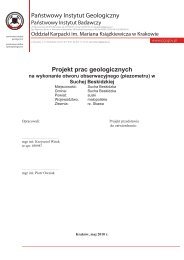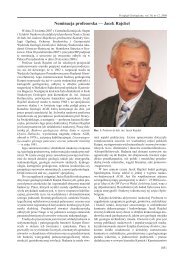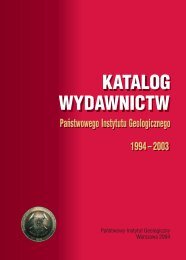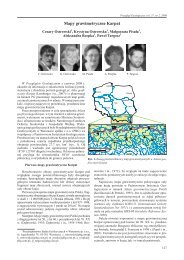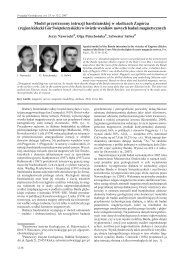Strike-slip tectonics within the SW Baltic Sea and its relationship to ...
Strike-slip tectonics within the SW Baltic Sea and its relationship to ...
Strike-slip tectonics within the SW Baltic Sea and its relationship to ...
Create successful ePaper yourself
Turn your PDF publications into a flip-book with our unique Google optimized e-Paper software.
100<br />
indica<strong>to</strong>rs of <strong>the</strong> tec<strong>to</strong>nic activity <strong>and</strong> uplift of such<br />
inverted fault (cf. Cartwright, 1989).<br />
NW–SE-oriented seismic line provides ano<strong>the</strong>r<br />
example of <strong>the</strong> Upper Cretaceous tec<strong>to</strong>nic <strong>and</strong> depositional<br />
pattern from <strong>the</strong> Bornholm–Darlowo Fault Zone<br />
(Fig. 7). This line is crossed by <strong>the</strong> most <strong>SW</strong> part of <strong>the</strong><br />
line B10A belonging <strong>to</strong> <strong>the</strong> multichannel seismic<br />
reflection survey completed in 1989 (comp. Sviridov<br />
et al., 1995 <strong>and</strong> <strong>the</strong>ir Fig. I.2.6a). However, detailed<br />
location data for line B10A of Sviridov et al. (1995)<br />
were not available, hence precise correlation of this line<br />
with <strong>the</strong> seismic line shown in Fig. 7 was not possible.<br />
Therefore, only general correlation of depositional<br />
un<strong>its</strong> identified on both seismic lines was completed.<br />
Due <strong>to</strong> significantly smaller spatial coverage of <strong>the</strong><br />
seismic experiment completed <strong>within</strong> <strong>the</strong> Polish terri<strong>to</strong>rial<br />
waters, it was not possible <strong>to</strong> distinguish all <strong>the</strong><br />
depositional un<strong>its</strong> described by Sviridov et al. (1995),<br />
<strong>and</strong> <strong>the</strong>refore some of <strong>the</strong> described depositional un<strong>its</strong><br />
include two un<strong>its</strong> of Sviridov et al. (1995).<br />
Along <strong>the</strong> line shown in Fig. 7, <strong>the</strong> very prominent<br />
progradational character of <strong>the</strong> Upper Cretaceous<br />
depos<strong>its</strong> can be observed. Within <strong>the</strong> entire Cretaceous<br />
sedimentary succession, five deposi<strong>to</strong>nal un<strong>its</strong><br />
delineated by <strong>the</strong> angular unconformities <strong>and</strong> <strong>the</strong>ir<br />
P. Krzywiec et al. / Tec<strong>to</strong>nophysics 373 (2003) 93–105<br />
correlative conformities were distinguished. Seismic<br />
reflec<strong>to</strong>rs are generally high-amplitude, high-continuity<br />
events, <strong>and</strong> can be easily traced <strong>within</strong> <strong>the</strong> particular<br />
sequences. Due <strong>to</strong> significant—mostly postdepositional—uplift<br />
of pop-up structure formed above<br />
basement strike-<strong>slip</strong> fault <strong>and</strong> observed in <strong>the</strong> central<br />
part of Fig. 7, it was only partly possible <strong>to</strong> correlate<br />
particular seismic un<strong>its</strong> across this structure.<br />
Oldest depositional unit A (approximately equivalent<br />
<strong>to</strong> un<strong>its</strong> 1 <strong>and</strong> 2 of Sviridov et al., 1995) identified<br />
along <strong>the</strong> seismic line presented in Fig. 7 rests directly<br />
on <strong>the</strong> Palaeozoic (Silurian?) basement. Within <strong>the</strong> NW<br />
part of this line (Fig. 7) <strong>its</strong> upper boundary is related <strong>to</strong><br />
<strong>the</strong> prominent erosional unconformity developed below<br />
<strong>the</strong> base of <strong>the</strong> Quaternary. Unit B (approximately<br />
equivalent <strong>to</strong> unit 3 of Sviridov et al., 1995) is characterised<br />
by clearly progradational seismic pattern, with<br />
oblique clinoforms developed above unit A. Its upper<br />
boundary is also related <strong>to</strong> erosional unconformity<br />
below <strong>the</strong> base of <strong>the</strong> Quaternary. Unit B is onlapped<br />
by unit C (equivalent of un<strong>its</strong> 4 <strong>and</strong> 5 distinguished by<br />
Sviridov et al., 1995) that is characterised by ra<strong>the</strong>r<br />
parallel <strong>and</strong> concordant reflec<strong>to</strong>rs. Erosional unconformity<br />
below <strong>the</strong> Quaternary succession is observed at<br />
<strong>the</strong> <strong>to</strong>p of this unit. Youngest un<strong>its</strong> D <strong>and</strong> E (equivalent<br />
Fig. 7. Seismic example of Upper Cretaceous deposi<strong>to</strong>nal <strong>and</strong> tec<strong>to</strong>nic architecture related <strong>to</strong> inversion <strong>and</strong> strike-<strong>slip</strong> movements <strong>within</strong> <strong>the</strong><br />
Bornholm– Darlowo Fault Zone. See Fig. 2 for location. Dotted lines: boundaries of identified depositional un<strong>its</strong> A, B, C, D, <strong>and</strong> E.<br />
Note prominent progradational pattern developed <strong>within</strong> <strong>the</strong> syn-inversion Upper Cretaceous succession. Arrows—general direction<br />
of progradation for <strong>the</strong> entire Upper Cretaceous inversion-related complex. See text for fur<strong>the</strong>r explanations.


